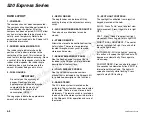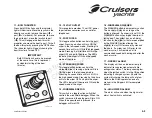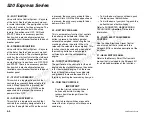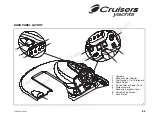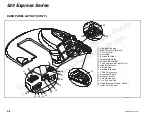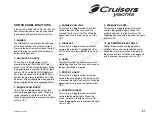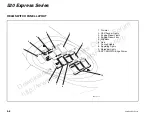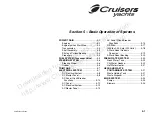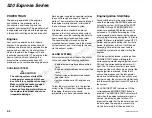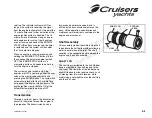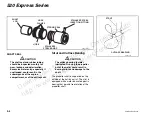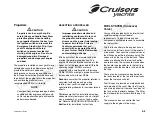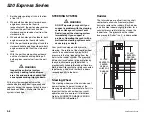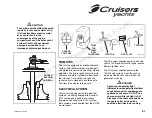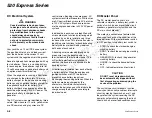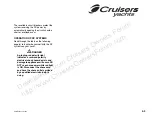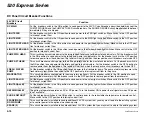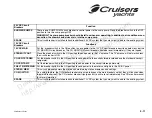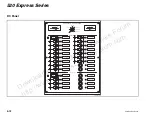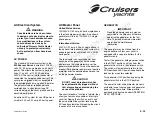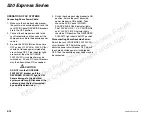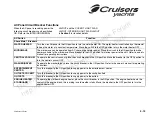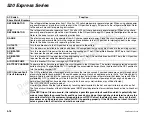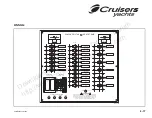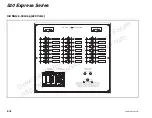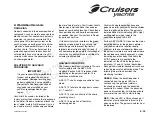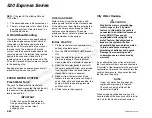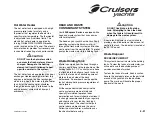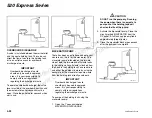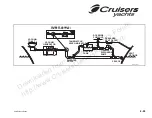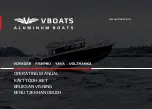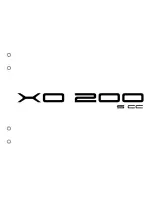
5-8
520 Express Series
520 Express Series
DC Electrical System
WARNING
Considerable care has been taken
to design a safe electrical system to
protect you from hazardous shocks.
Any modifications to the system
should always be done by an
authorized Cruisers Yachts Dealer
not only to protect your warranty,
but to protect you from hazardous
shock.
Your yacht has a 12 volt DC house system.
The positive wire is hot, and feeds current
from the batteries to the various 12 volt
systems and the negative wire is the ground.
Several engine options are equipped with up
to six batteries. There is a cranking battery
for each engine, two batteries in parallel for
12 volt house power, a generator battery and
an optional bow thruster battery.
When the engines are running, all batteries
are charged by the alternators. There is a
battery charger for the house and cranking
batteries and an optional battery charger for
the optional bow thruster battery. The
battery chargers are powered by either the
dockside or generator 120V AC power. The
generator battery is charged by the
generator.
The DC system wires are identified by three
colors. Red wires are +12 volts, yellow wires
are DC common and gray wires are DC
control wires. Bonding wires are green. AC
system wires utilize three colors. White wires
are AC neutral. Black wires are AC hot wires
in 120V AC systems. Black and red wires
are the ungrounded wires in 240V AC power
systems.
Individual harness wires are identified with
wire number and function by lettering which
is printed by an ink jet printer every three
inches on the wires. This information aids in
identifying wire functions for troubleshooting.
Battery cables are identified by labels on
both ends of each cable.
A bonding wire is extended through a #6
green wire from the bonding strip to a
terminal behind the instrument panel. This
will facilitate electronics installation. In
addition, the handrails are attached to the
bonding system.
All batteries are isolated from each other by
a battery isolator. When the engines and
ignition switches are OFF the isolator
prevents house battery loads from
discharging the cranking batteries. When the
batteries are being charged by the
alternators, the isolator automatically
isolates the batteries and will distribute the
charge among the batteries according to
individual need.
DC Master Panel
The DC master panel consists of a
voltmeter, ammeter, a battery test switch, a
series of switch type and resettable circuit
breakers, a generator start switch, and the
DC main circuit breaker.
The meter is a convenience feature which
allows you to check on the condition of the
three batteries. With master breaker switch
in OFF position, turn battery test switch to:
• STBD - to check the starboard engine
cranking battery
• PORT - to check the port engine cranking
battery
• GENERATOR - to check the generator
cranking battery
• HOUSE - to check the house batteries
and
• OFF - to disable meter and test circuit
CAUTION
DO NOT reset a breaker which has
been automatically tripped without
first discovering and remedying the
cause of the problem.
The switch type circuit breakers’ function
allows you to manually enable or interrupt a
circuit by moving the switch on or off, and
they protect the system receiving the DC
power by automatically opening the circuit
should a short or overload condition occur.
Downloaded
from
Cruisers
Owners
Forum
http://www.CruisersOwnersForum.com

